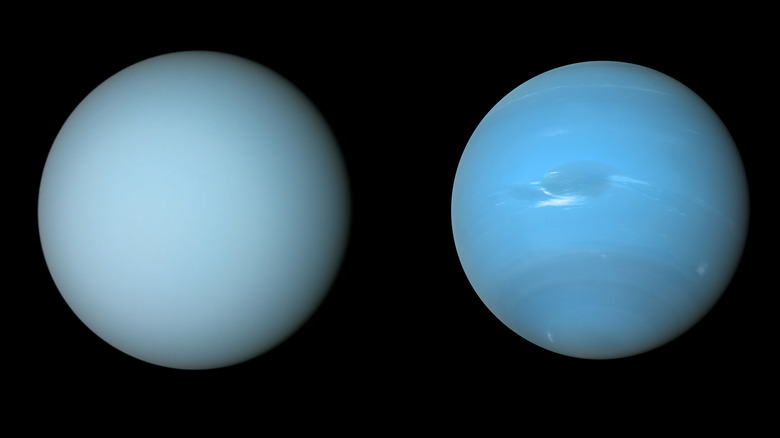Here's Why Uranus And Neptune Are Different Colors
Out in the depths of the solar system lie the far-off ice giant planets. Uranus and Neptune are extremely far away at 20 and 30 times farther from the sun than the Earth is, according to NASA, and they are rarely visited by spacecraft so there's a lot we don't know about them. However, one thing we do know is their distinctive colors: Uranus is a light blue-green shade and Neptune is a brighter blue.
In 2022, research using the Gemini North Telescope, the NASA Infrared Telescope Facility, and the Hubble Space Telescope helped to explain why these two similar planets have different colors, as presented in a paper in the Journal of Geophysical Research: Planets, and it has everything to do with their atmospheres. The reason Uranus has a blue glow is because of the methane in its atmosphere, which joins other gases like hydrogen and helium, and it reflects blue light.
Neptune has methane in its atmosphere as well, which is why it also appears blue, but it's a different shade of blue from Uranus. Both planets have a hazy appearance, too, almost as if they are glowing. The researchers found that it is this haze that makes the difference in color between the two planets. If neither planet had this haze, they would appear the same color (via NOIRLab).
What the haze is made of
The data from the telescopes were used to create a model of the planets' atmospheres and in particular, the many different layers that exist in those atmospheres. The particles that create the haze are in deeper atmospheric layers, which weren't well understood because most previous observations had looked at their upper atmospheres, according to the researchers.
The haze particles are found in the middle of three atmospheric layers, in a layer technically called the Aerosol-2 layer. The atmospheres are extremely cold this far from the sun — in fact, they are so cold that the methane can condense into ice and create methane snow. And because Neptune's atmosphere is more active than Uranus', the methane particles get jiggled around more and don't have so much chance to form a layer. That means the Aerosol-2 layer is thicker on Uranus than on Neptune, and it is these methane particles that cause the hazy effect.
So Neptune looks brighter blue because it has less haze, and Uranus looks like a soft blue because it has more haze. This neat finding was serendipitous as the researchers weren't actually investigating the planets' colors specifically. "We hoped that developing this model would help us understand clouds and hazes in the ice giant atmospheres," explained one of the researchers, Mike Wong of the University of California, Berkeley. "Explaining the difference in color between Uranus and Neptune was an unexpected bonus!"
